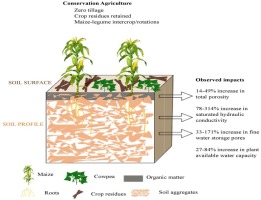Soil and Tillage Research ( IF 6.1 ) Pub Date : 2020-04-16 , DOI: 10.1016/j.still.2020.104639 Samuel Eze 1 , Andrew J Dougill 1 , Steven A Banwart 1 , Thirze D G Hermans 1 , Ivy S Ligowe 2 , Christian Thierfelder 3

|
Sub-Saharan Africa (SSA) faces climate change and food insecurity challenges, which require action to create resilient farming systems. Conservation agriculture (CA) is widely promoted across SSA but the impacts on key soil physical properties and functions such as soil structure and hydraulic properties that govern water storage and transmission are not well understood. The aim of this study was to assess the impacts of long term (10–12 years) maize-based CA on soil hydraulic conductivity, water retention and pore size distribution. Root zone (0–30 cm depth) soil total porosity, pore size distribution, saturated hydraulic conductivity (Ksat) and plant available water capacity (PAWC) of conventional maize monocrop farming systems (CP) are compared with those of adjacent CA trials with either sole maize or maize intercrop/rotation with cowpea (Vigna unguiculata L.), pigeon pea (Cajanus cajan L.) or velvet bean (Mucuna pruriens L) in trial locations across central and southern Malawi. Results show that maize-based CA systems result in significant changes to soil hydraulic properties that correlate with improved soil structure. Results demonstrate increases of 5–15 % in total porosity, 0.06−0.22 cm/min in Ksat, 3–7 % in fine pores for water storage and 3–6 % in PAWC. Maize monocrop CA had similar effect on the hydraulic properties as the maize-legume associations. The values of Ksat for CA systems were within optimum levels (0.03–0.3 cm/min) whereas PAWC was below optimum (<20 %). There was no significant build-up in soil organic matter (OM) in the CA systems. The results lead to a recommendation that crop residue management should be more pro-actively pursued in CA guidance from agricultural extension staff to increase soil OM levels, increase yields and enhance climate resilience of sub-Saharan African farming systems.
中文翻译:

保护性农业对马拉维农业系统土壤结构和水力特性的影响。
撒哈拉以南非洲(SSA)面临气候变化和粮食不安全的挑战,这需要采取行动来建立有弹性的耕作制度。在整个SSA中,保护性农业(CA)得到了广泛的推广,但是对关键土壤物理特性和功能(例如控制储水和输水的土壤结构和水力特性)的影响尚不清楚。这项研究的目的是评估基于玉米的长期(10-12年)CA对土壤水力传导率,保水率和孔径分布的影响。根区(0-30厘米深)土壤总孔隙度,孔径分布,饱和导水率(K饱和)和常规玉米单作农作系统(CP)的植物可用水容量(PAWC)与单独玉米或玉米间作/轮作的cow豆(Vigna unguiculata L.),木豆(Cajanus cajan L )或天鹅绒豆(Mucuna pruriens L)在马拉维中部和南部的试验地点。结果表明,基于玉米的CA系统导致土壤水力特性发生显着变化,这与改善的土壤结构相关。结果证明在总孔隙率5-15%的增加,0.06-0.22厘米/分钟以K饱和,用于储水的细孔中为3–7%,在PAWC中为3–6%。玉米单作CA对水硬性的影响与玉米-豆科协会相似。CA系统的饱和碳酸钾值在最佳水平(0.03-0.3 cm / min)以内,而PAWC低于最佳水平(<20%)。在CA系统中,土壤有机质(OM)没有显着增加。结果得出建议,应在农业推广人员的农业评估指导下更积极地进行作物残留管理,以增加土壤有机肥水平,增加产量并增强撒哈拉以南非洲农业系统的气候适应能力。











































 京公网安备 11010802027423号
京公网安备 11010802027423号